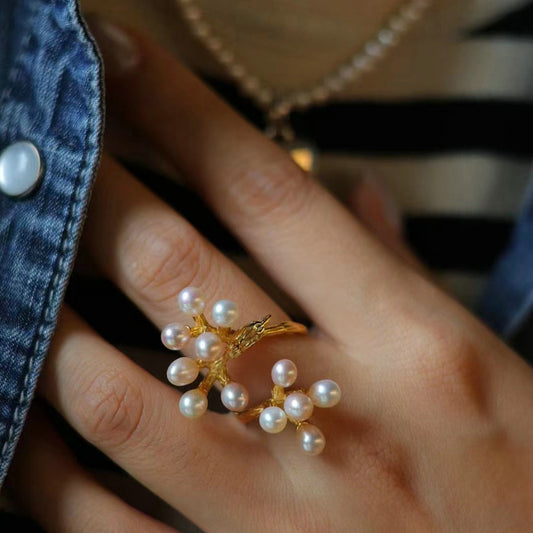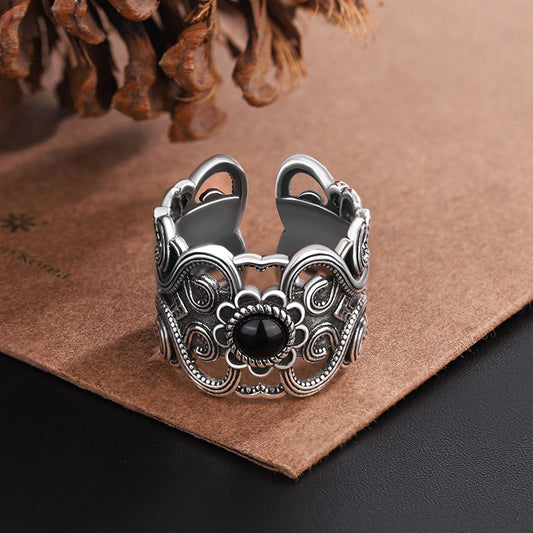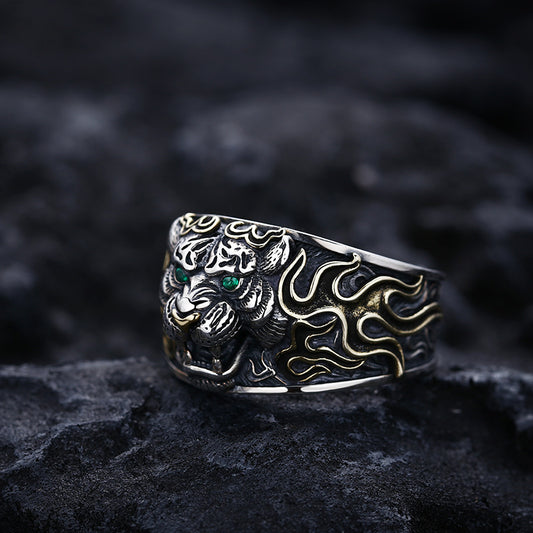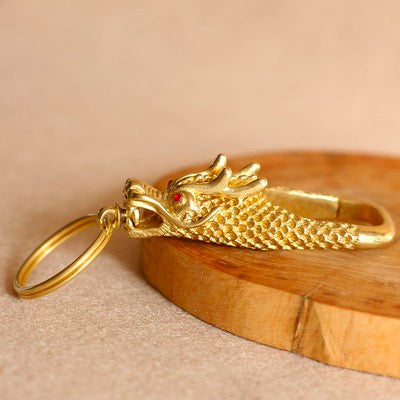Chinese traditional rings are an important form of jewelry in Chinese culture, boasting a long history and rich cultural significance. This article explores the origins, development, and cultural meanings of Chinese traditional rings, as well as the differences between Chinese and Western rings.
History of Chinese Rings
The history of rings in China dates back to the Neolithic period. During this time, people began to create and use finger rings as both decorations and auxiliary tools for hunting. These rings were often made from materials such as animal bones, tusks, and jade, coming in various shapes and sometimes adorned with patterns. In 1959, archaeologists discovered 20 rings at the Dawenkou site in Taian, Shandong Province, with 9 of them still attached to the fingers of the deceased, indicating that these rings held not only practical value but also special significance.
During the Shang Dynasty, finger rings came to be known as "wei" and became a distinctive form of ornament. At that time, people frequently engaged in hunting with bows and arrows, which often caused abrasions on the thumb. This led to the development of a ring-like ornament known as "wei" that was worn on the thumb to aid in drawing the bowstring. This represents one of the earliest recorded uses of rings beyond decoration.
By the Qin and Han Dynasties, rings had become common adornments. Before the Han Dynasty, rings were symbols of status for palace concubines and had distinctions between left and right hands. Concubines would wear silver rings on their right hand to indicate their freedom to enter and exit the palace. However, if they were pregnant or undergoing physiological changes that prevented them from attending the emperor, they would wear a gold ring on their left hand as a sign of prohibition. As a result, rings were referred to as "jie zhi" during this time.
In addition to being accessories, rings were imbued with various cultural meanings. In different historical periods, rings represented different concepts and symbols. For instance, in ancient Egypt, rings served as talismans representing power and divine energy; during the European Middle Ages, rings symbolized marriage, signifying the strong and stable bond between spouses; in traditional Chinese culture, rings are often regarded as symbols of love, exchanged between couples as tokens of affection.
Origins of Chinese Traditional Rings
The origins of Chinese traditional rings can be traced back to the Neolithic era when exquisite jade jewelry started to be crafted. By the Shang Dynasty, jade rings had become symbols of status. In the Zhou Dynasty, rings began to represent tokens of affection, becoming gifts exchanged between lovers. During the Spring and Autumn and Warring States periods, the quantity and quality of jade craftsmanship reached its zenith, further popularizing jade rings.
Development of Chinese Traditional Rings
As time progressed, Chinese traditional rings continued to evolve. By the Tang Dynasty, rings had gained popularity and became fashionable accessories. From the Song Dynasty onwards, rings became commonplace adornments for women. In the Ming Dynasty, ring-making techniques reached their peak, introducing intricate craftsmanship such as inlaying and carving.

During the Qing Dynasty, rings saw even more widespread use. Additionally, the general populace in the Qing Dynasty embraced ring-wearing, particularly favoring gold and jade rings.
Cultural Significance of Chinese Traditional Rings
Chinese traditional rings possess profound cultural meanings. Firstly, rings symbolize tokens of affection, representing emotions and marriages between couples. Secondly, rings are viewed as protective amulets, capable of warding off evil and disaster. Furthermore, rings are regarded as lucky charms, symbolizing happiness, peace, and longevity.
Chinese traditional ring elements
Traditional Chinese ring elements are an integral part of Chinese culture, carrying rich cultural connotations and historical memories. Among them, auspicious clouds and gourds are some of the most common ring designs.
Auspicious clouds are symbols of good fortune in traditional Chinese culture, widely utilized in clothing, architecture, crafts, and more. In ring designs, the motif of auspicious clouds is frequently employed. The design of auspicious clouds typically consists of simple curves, outlining a full and luxurious aura, enriched with layers. When inset with diamonds, designers often arrange the diamonds along the curves of the auspicious clouds, making the entire ring shine brilliantly.
Gourds are another auspicious symbol in traditional Chinese culture, commonly seen in folk customs and religious beliefs. In ring designs, the gourd motif is also widely used. The design of gourds usually comprises smooth curves, delineating a full and rounded quality. The symbolism of the gourd is profound, representing auspiciousness, blessings, and longevity. Therefore, the gourd motif is extensively incorporated into ring designs.
In addition to auspicious clouds and gourds, traditional elements like dragons and phoenixes, as well as flora and fauna, are also prevalent in ring designs. Dragons and phoenixes are auspicious symbols in traditional Chinese culture, extensively used in clothing, architecture, crafts, and more. In ring designs, the motifs of dragons and phoenixes are widely employed. Their designs typically consist of flowing curves, depicting a full and luxurious aura. Floral and fauna motifs are more delicate and graceful, often composed of elements like petals, leaves, and birds. These elements harmoniously interact, forming beautiful and harmonious compositions.
Types of Chinese Rings
There are various types of rings in China, among which four are more common: diamond-set rings, engraved character rings, plain rings, and filigree rings.
Diamond-set rings are made of metals such as gold, platinum, or silver, and adorned with various gemstones. These rings are characterized by their splendid and dazzling appearance, making them suitable for formal occasions.
Engraved character rings were prevalent in China during the Qing Dynasty. They feature auspicious characters such as "福" (fortune), "禄" (wealth), "寿" (longevity), "禧" (happiness), "发" (prosperity), and "如意" (as you wish) engraved on them. These rings not only carry blessings but also hold significant artistic value.
Plain rings, also known as "素身戒" (plain body rings), have no patterns, designs, or inlays on the surface of the ring band. They are often handcrafted or hammered by machinery. These rings are simple and elegant, suitable for everyday wear.
Filigree rings are crafted using the intricate technique of filigree work. Filigree work is an ancient and exquisite method of gold and silver craftsmanship, resulting in delicate and beautiful rings. These rings are ideal gifts for family and friends.
Chinese Ring Craft
Chinese ring craftsmanship is diverse and intricate, with several important steps including wax modeling, gemstone selection and setting, carving and polishing, stone inlay, and final polishing.
Firstly, wax modeling is the initial step in crafting a ring. A wax model is created and placed within a mold, which is then heated to melt away the wax, leaving space for molten metal to be poured in, forming the ring band.
Secondly, gemstone selection and setting are crucial. High-quality gemstones are chosen and meticulously shaped to match the designer's envisioned color, shape, and size. If other colored gemstones or diamonds are part of the design, they are also selected accordingly.
Next, for rings requiring carving, once suitable gemstones are chosen, they are intricately carved according to the designer's theme and design. The carved surface is then polished to a smooth finish. Ring faces are typically much smaller compared to other carved jade items, demanding a higher level of craftsmanship.
Following that, gemstone inlay work is of utmost importance.
The final step is polishing. After the ring is assembled, both the ring band and face may have small burrs or imperfections that require further polishing to ensure comfortable wear.
In summary, the process involves wax modeling, gemstone selection and setting, carving and polishing, stone inlay, and final polishing to create a Chinese ring with exquisite craftsmanship.
Differences Between Chinese Traditional Rings and Western Rings
Chinese traditional rings differ significantly from Western rings. Firstly, in terms of materials, Chinese traditional rings predominantly use natural materials such as jade, jadeite, and agate, whereas Western rings primarily employ metallic materials. Secondly, in terms of design, Chinese traditional rings tend to feature simpler forms, emphasizing the natural colors and textures of the stones, while Western rings often showcase intricate designs, focusing on craftsmanship and aesthetics. Finally, regarding cultural significance, Chinese traditional rings carry deeper cultural meanings, whereas Western rings place greater emphasis on decoration and fashion.
Conclusion
Chinese traditional rings are a significant form of jewelry in Chinese culture, encompassing a rich history and profound cultural connotations. In contrast to Western rings, Chinese traditional rings prioritize the natural and simple aspects of materials and design, while also carrying deeper cultural significance. In today's society, Chinese traditional rings continue to be cherished and pursued by many, with their cultural meanings and artistic value continuously being explored and passed down.























